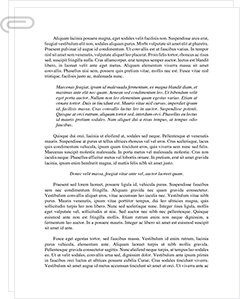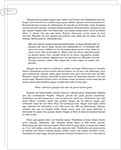 Study Document
Study Document
Bacteriological Analysis Of Water Tanks In Residential Areas Essay
Pages:8 (2261 words)
Document Type:Essay
Document:#556038
Essay Topic Examples
1. The Prevalence and Types of Bacterial Contaminants in Residential Water Tanks:
This essay delves into the different types of bacterial populations commonly found in residential water tanks. It analyses the factors that influence bacterial growth, such as temperature and tank materials, and discusses the potential health risks associated with these contaminants.
2. The Effects of Maintenance and Sanitation Practices on Bacterial Levels in Residential Water Tanks:
This topic explores how regular maintenance and cleaning regimens impact the bacteriological quality of water in residential tanks. The essay would compare the bacterial analyses results from well-maintained tanks with those receiving minimal to no maintenance.
3. Bacteriological Analysis Versus Chemical Treatment: Strategies for Ensuring Safe Residential Water:
This essay addresses the balance between bacteriological analysis and the use of chemical treatments to ensure safe drinking water in residential areas. It assesses the effectiveness, benefits, and potential drawbacks of both methods and their implications for public health.
4. The Role of Bacteriological Analysis in Public Health Surveillance of Residential Water Supplies:
This topic investigates how bacteriological analysis of water tanks in residential areas can serve as an early warning system for public health issues. This essay discusses the importance of regular testing and how data from these analyses can be used to prevent disease outbreaks.
5. Technological Advancements in Bacteriological Analysis of Water and Their Impact on Residential Health and Safety:
This essay examines recent technological advancements in the field of bacteriological analysis and their impact on the detection and management of waterborne pathogens in residential water tanks. It discusses the potential for new technology to improve monitoring efficiency and ensure safer water supplies.
Essay Title Examples
1. The Hidden Microbial Universe: Decoding Bacterial Profiles in Residential Water Tanks
2. Water Tank Woes: A Bacteriological Examination of Urban Domestic Water Storage
3. Assessing Public Health Risks: A Study on Bacterial Contamination in Household Water Tanks
4. Unseen Invaders: Bacterial Surveillance and Analysis of Residential Water Reservoirs
5. Ensuring Safe Sips: A Comprehensive Bacteriological Analysis of Residential Water Tanks
Essay Hook Examples
1. Imagine a microscopic battleground in the very water tanks above our heads, where the quality of our waterand the health of our familiesis silently being decided.
2. What if I told you that the water you're drinking might hold a hidden community of microorganisms, some of which could pose serious threats to your health?
3. As urban dwellings rise skywards, the water tanks that crown our buildings potentially incubate unseen bacteria, raising the vital question: what's really in the water we use every day?
4. The water tank of a residential area: a common sight, often overlooked, but what surreptitious secrets are lurking in its depths?
5. "Out of sight, out of mind" they say, but when it comes to the bacteriological realities of our residential water tanks, what we can't see can indeed hurt us.
Thesis Statement Examples
1. The bacteriological analysis of water tanks in residential areas reveals a significant correlation between irregular cleaning schedules and the proliferation of waterborne pathogens, posing a serious health threat to residents.
2. Advanced molecular techniques in bacteriological analysis, such as quantitative PCR, demonstrate a higher prevalence of antibiotic-resistant bacteria in residential water tanks, underscoring the need for stringent water treatment practices.
3. Seasonal variations in temperature and humidity are found to be critical factors affecting bacterial diversity and concentration in residential water tanks, necessitating a seasonal approach to water management and safety protocols.
4. The prevalence of coliforms in residential water tanks highlights deficiencies in current water storage infrastructure and points to the urgent need for improved tank design and maintenance guidelines to ensure safe drinking water.
5. A comparative study of bacteriological analysis results from residential water tanks indicates that community-based water safety education significantly reduces the incidence of waterborne diseases by promoting better hygiene and maintenance practices.
Essay Outline Examples
I. Introduction
Significance of Water Tank Analysis
Importance of clean water for health
Risks associated with contaminated water
Overview of Bacteriological Analysis
Definition of bacteriological analysis
Common bacteria found in water tanks
II. Body
Methodology of Bacteriological Analysis
Sampling techniques for water analysis
Laboratory methods for detecting bacteria
Results from Residential Area Water Tanks
Summary of bacteriological findings
Interpretation of analysis results
Implications and Health Concerns
Potential health outbreaks
Preventive measures and safety guidelines
III. Conclusion
Summary of Key Findings
Reiteration of the importance of water tank cleanliness
Summary of bacteriological analysis results
Recommendations for Residential Areas
Maintenance strategies for water tanks
Policy implications for public health
Essay Introduction Examples
Introduction Paragraph 1
Water tanks in residential areas are an essential component of the water supply system, providing a reliable source of water for household use. However, these tanks can also become breeding grounds for various bacteria, making it crucial to conduct regular bacteriological analysis to ensure the quality and safety of the water. By analyzing the bacterial content of water tanks, residents can identify any potential health risks and take necessary measures to prevent contamination.
Bacteriological analysis of water tanks involves testing for the presence of harmful bacteria such as E. coli, coliforms, and other pathogenic microorganisms. These bacteria can enter water tanks through various means, including rainwater runoff, bird droppings, and insect infestations. Once inside the tank, these bacteria can multiply rapidly in the warm and nutrient-rich environment, posing a significant risk to the health of individuals who consume the contaminated water. Regular analysis of water tanks can help identify these contaminants early and prevent the spread of waterborne diseases.
In addition to identifying harmful bacteria, bacteriological analysis of water tanks also helps assess the overall cleanliness and maintenance of the tanks. Accumulation of sediment, algae growth, and biofilm formation can provide a favorable environment for bacteria to thrive. By analyzing the bacterial content of water tanks, residents can gain valuable insights into the condition of their tanks and take appropriate measures to clean and disinfect them. This proactive approach cn help prevent future bacterial contamination and ensure the continuous supply of clean and safe water.
Introduction Paragraph 2
Conducting bacteriological analysis of water tanks in residential areas is crucial for safeguarding public health and ensuring the quality of drinking water. The presence of harmful bacteria in water tanks can lead to outbreaks of waterborne diseases, putting residents at risk of gastrointestinal infections and other health issues. By regularly testing water samples from tanks for bacterial contamination, residents can proactively monitor and maintain the safety of their water supply. This preventive measure not only protects the well-being of individuals but also helps maintain the integrity of the…
…and condition of these tanks become paramount for ensuring a safe supply. This essay will delve into the methodologies of sampling and analyzing residential water tanks, the types of bacteria commonly found, the health implications of contamination, and current strategies for maintaining water safety in residential environments.
Paragraph 2
As urbanization continues to spread, the infrastructure to support growing populations, including the provision of potable water, is under increasing scrutiny. In the quiet hum of our daily lives, water tanks perched atop residential buildings silently ensure a steady flow of water to our faucets. Yet, the quality of this life-sustaining resource is often taken for granted, overshadowed by its ready availability. The practice of bacteriological analysis of these water tanks is an unseen but vital process that safeguards public health, identifying and mitigating the potential for waterborne diseases. This essay aims to explore the significance of bacteriological analysis in residential settings, examining the risks associated with neglect, the impact on community health, and the policies that guide safe water storage practices.
Essay Conclusion Examples
Conclusion 1
In conclusion, the comprehensive bacteriological analysis of water tanks in residential areas has delineated the critical importance of ongoing monitoring to ensure public health. The findings underscore the prevalence of potentially harmful bacteria, the factors contributing to contamination, and the effectiveness of maintenance and disinfection protocols. As residents rely on these water sources for their daily needs, it is imperative that regulatory bodies establish stringent guidelines and regular inspection routines to mitigate risks. Moreover, the community must be educated about the significance of these measures to foster compliance and proactivity in maintaining water safety. The health of the community depends not just on the quality of the water supply, but on the collective responsibility in preserving it. Therefore, a collaborative effort between homeowners, municipal authorities, and health agencies is crucial in guaranteeing the safety and purity of our essential water resources.
Conclusion 2
In drawing this essay to a close, it is evident that the bacteriological analysis of water tanks in residential regions is a matter of vital public interest. Our investigation has illuminated the variegated nature of bacterial presence within these water systems, highlighting the necessity for routine examinations and adherence to established health standards. The interplay between environmental conditions, structural maintenance, and resident awareness has been shown to be pivotal in sustaining water quality. To this end, it is paramount that concerted action is taken to fortify these practices, ensuring that the sanctity of our water supply is not compromised. The commitment to vigilance and education stands as a bulwark against the incursion of contamination, underscoring our collective stewardship over this precious resource. Let this essay serve as a clarion call to all stakeholders to unite in the pursuit of an unassailable water supply, thereby safeguarding the health and well-being of our communities for generations to come.
In-Text Citation Examples
In-text citation examples:
1. To ensure the safety of drinking water from residential water tanks, it is crucial to adhere to the bacteriological analysis procedures outlined in the American Public Health Association's "Standard Methods for the Examination of Water and Wastewater" (23rd ed., p. 45).
2. The World Health Organization has developed specific guidelines to maintain the quality of drinking water, which include monitoring for bacterial contaminants as an essential aspect of water quality management ("Guidelines for Drinking-Water Quality" 4th ed., ch. 11).
Sources Used:
1. American Public Health Association. Standard Methods for the Examination of Water and Wastewater. 23rd ed., American Public Health Association, 2017.
2. World Health Organization. Guidelines for Drinking-Water Quality. 4th ed., World Health Organization, 2011.
Primary Sources
World Health Organization. Guidelines for Drinking-Water Quality. 4th ed., World Health Organization, 2011.
American Public Health Association. Standard Methods for the Examination of Water and Wastewater. 23rd ed., American Public Health Association, 2017.
United States Environmental Protection Agency. Manual of Methods for Virology. Office of Research and Development, United States Environmental Protection Agency, 2001.
Centers for Disease Control and Prevention. Surveillance for Waterborne Disease Outbreaks Associated with Drinking Water and Other Nonrecreational Water. U.S. Department of Health & Human Services, 2013.
Payment, Pierre, et al. A Randomized Trial of Three Water Treatment Interventions for Preventing Waterborne Disease among People with Undiminished Immune Function. Microbiological Risk Assessment in Food Processing, edited by Martin Adams and John Barlow, Woodhead Publishing, 2002, pp. 113-123.
Related Documents
 Study Document
Study Document
Bacteriological Analysis Of Water Tanks In Residential Areas
1. The Prevalence and Dangers of Coliform Bacteria in Residential Water Tanks: This essay would explore the presence of coliform bacteria in residential water tanks, identifying the types commonly found, like Escherichia coli. The focus would be on the implications for public health, the risks of waterborne diseases, and the conditions that favor the growth of these pathogens. 2. Impact of Water Storage Practices on Bacteriological Quality in Residential Areas: An




